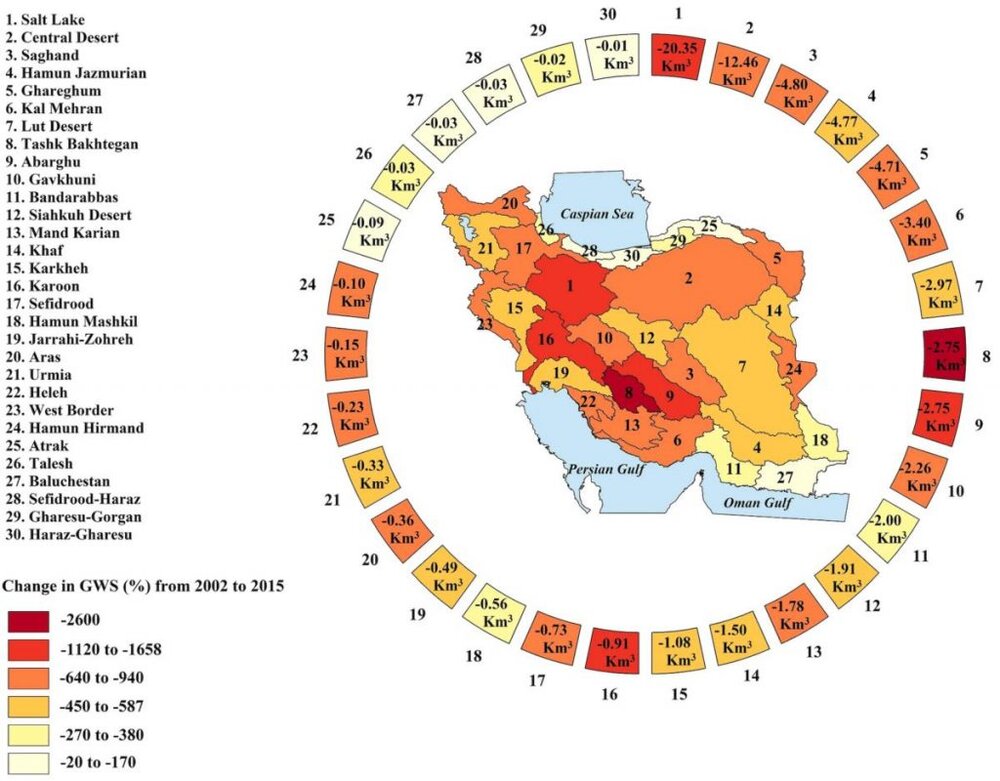A new comprehensive statistical study about the use of groundwater by Iran’s government has determined the situation of 30 basins in the country and concluded that from 2002 to 2015, more than 74 billion cubic meters of groundwater aquifers have been extracted in Iran.
This statistic is unprecedented, especially when considering that the total reservoirs of all dams in the country have a capacity of about 50 billion cubic meters. In other words, in the last 14 years, 22 billion cubic meters more than the capacity of all dam reservoirs have been extracted from the country’s underground sources.
This statistic shows that the government in Iran pays no attention to the ecological potential of the land, and the continuation of this trend has caused a very worrying phenomenon of land subsidence in the country.

Now Iran holds the record for ground subsidence on the planet. Land subsidence is a phenomenon that, when it occurs on a plain, turns the area into a dead plain and takes at least 50,000 years to regain resilience. It may take several thousand years to compensate for a 14-year catastrophe in Iran’s groundwater resources.
Therefore, the situation of Iran’s groundwater resources is very dangerous, and if this catastrophe is not addressed quickly, the future generations of this land may live on a dead land, thanks to the negligence of the current regime in Iran.
Mohamad Darvish, an environment expert, said about a solution for this catastrophe: “In the first place, the dependence of livelihoods on water and soil resources must be reduced and governments must move towards the extraction of clean energy, including wind and solar energy. In the Sixth Five-Year Plan, the government was required to provide 5,000 megawatts of electricity from new energy sources. If this important thing is done, the pressure on thermal power plants, which is one of the main factors of water consumption in our country, will be reduced.”
He added: “With the money generated from the sale of clean energy to the eastern neighbor, the water needed can be supplied from Helmand to alleviate the crisis that is now plaguing the east of the country; It is also necessary to provide conditions for the country’s specialized forces to move towards the production of secondary products and to prevent the sale of raw materials, which are highly water-intensive.”
Desperate about the government’s policies that have led to the destruction of Iran’s lands, he added: “There is a lot of potential for income and development in the country, and so to speak, not all eggs should be put in one basket; A country whose average rainfall is one-third of the global average and its rainfall from year to year may change up to 80 percent, should not look to the sky alone, and we should use strategies to reduce the dependence on water and soil resources.”
About the incompetence and wrong administration of the regime’s Ministry of Power, he added: “The first condition is that water management is based on the geomorphological and morphometric facts of catchments, but unfortunately this principle was not observed and for years they managed water based on political boundaries and regional water organizations were formed. This approach was very wrong.
“For example, Karsivand rivers are in one province, Fars province, and do not have the problem of catchment areas such as Zayandehrud, which is between Chaharmahal and Isfahan provinces, but the same catastrophe occurred there as in Zayandehrud, Lake Urmia and Khuzestan; Therefore, in order to realize the management of water basins, political will must have an ecological understanding.”
And the clerical establishment with an underdeveloped system lacks such a system. Finally in a recent article in the journal Nature, three Iranian researchers living in North America exposed the worrying condition of Iran’s groundwater resources.
Samaneh Ashraf, Ali Nazemi and Amir AghaKouchak, in an article published on April 28 in the journal ‘Scientific Reports’ published by the Nature Group, analyzed the situation of Iran’s groundwater aquifers over a 14-year period from 2002 to 2015 and wrote:
“The impact of depletion in Iran’s groundwater reserves is already manifested by extreme overdrafts in ~ 77% of Iran’s land area, a growing soil salinity across the entire country, and increasing frequency and extent of land subsidence in Iran’s planes. While meteorological/hydrological droughts act as triggers and intensify the rate of depletion in country-wide groundwater storage, basin-scale groundwater depletions in Iran are mainly caused by extensive human water withdrawals. We warn that continuation of unsustainable groundwater management in Iran can lead to potentially irreversible impacts on land and environment, threatening country’s water, food, socio-economic security.”